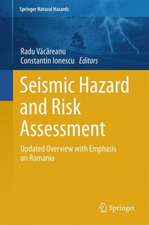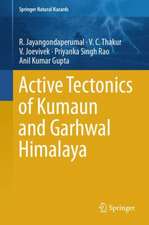Disaster Vulnerability, Hazards and Resilience: Perspectives from Florida: Environmental Hazards
Autor Fernando I. Rivera, Naim Kapucuen Limba Engleză Hardback – 29 mai 2015
Readers will find insightful answers to such questions as: How can the concept of resilience be used as a framework to investigate the conditions that lead to stronger, more sustainable communities? What factors account for the variation across jurisdictions and geographic units in the ability to respond to and recover from a disaster? How does the recovery process impact the social, political and economic institutions of the stricken communities? How do communities, especially rural ones, collaborate with multiple stakeholders (local, regional, state, national) during the transition from recovery to resilience? Can the collaborative nature of disaster recovery help build resilient communities?.
The primary audiences of this book are scholars in emergency and crisis management, planning and policy, disaster response and recovery, disaster sociology and environmental management and policy. This book can also be used as a textbook in graduate and advanced undergraduate programs / courses on disaster management, disaster studies, emergency and crisis management, environmental policy and management and public policy and administration.
| Toate formatele și edițiile | Preț | Express |
|---|---|---|
| Paperback (1) | 554.72 lei 39-44 zile | |
| Springer International Publishing – 9 oct 2016 | 554.72 lei 39-44 zile | |
| Hardback (1) | 643.16 lei 6-8 săpt. | |
| Springer International Publishing – 29 mai 2015 | 643.16 lei 6-8 săpt. |
Preț: 643.16 lei
Preț vechi: 756.65 lei
-15% Nou
Puncte Express: 965
Preț estimativ în valută:
123.06€ • 129.18$ • 102.15£
123.06€ • 129.18$ • 102.15£
Carte tipărită la comandă
Livrare economică 10-24 aprilie
Preluare comenzi: 021 569.72.76
Specificații
ISBN-13: 9783319164526
ISBN-10: 331916452X
Pagini: 195
Ilustrații: XXIII, 200 p. 37 illus., 14 illus. in color.
Dimensiuni: 155 x 235 x 17 mm
Greutate: 0.49 kg
Ediția:2015
Editura: Springer International Publishing
Colecția Springer
Seria Environmental Hazards
Locul publicării:Cham, Switzerland
ISBN-10: 331916452X
Pagini: 195
Ilustrații: XXIII, 200 p. 37 illus., 14 illus. in color.
Dimensiuni: 155 x 235 x 17 mm
Greutate: 0.49 kg
Ediția:2015
Editura: Springer International Publishing
Colecția Springer
Seria Environmental Hazards
Locul publicării:Cham, Switzerland
Public țintă
ResearchCuprins
Chapter 1. Introduction.- Chapter 2. Emergency Management in Florida.- Chapter 3. Geography and Resilience.- Chapter 4. Hazards.- Chapter 5. Vulnerability.- Chapter 6. Resilience.- Chapter 7. The Path to Resilience.- Chapter 8. Communicating Resilience.- Chapter 9. Disaster Resilience in Rural Communities.- Chapter 10. Farmworkers in Resilience.- Chapter 11. Tourism and Resilience.- Chapter 12. Conclusion.- Chapter 13. Appendices A, B, C.
Textul de pe ultima copertă
This monograph provides valuable lessons in building disaster resilience for rural communities and beyond. With a focus on Florida, the authors present a comprehensive review of the current debates surrounding the study of resilience, from federal frameworks, state plans and local initiatives. They also review evaluation tools and feature first-hand accounts of county emergency managers as well as non-profit and community groups on key issues, including perspectives on vulnerable groups such as the elderly, children and farm workers.
Readers will find insightful answers to such questions as: How can the concept of resilience be used as a framework to investigate the conditions that lead to stronger, more sustainable communities? What factors account for the variation across jurisdictions and geographic units in the ability to respond to and recover from a disaster? How does the recovery process impact the social, political and economic institutions of the stricken communities? How do communities, especially rural ones, collaborate with multiple stakeholders (local, regional, state, national) during the transition from recovery to resilience? Can the collaborative nature of disaster recovery help build resilient communities?
The primary audiences of this book are scholars in emergency and crisis management, planning and policy, disaster response and recovery, disaster sociology and environmental management and policy. This book can also be used as a textbook in graduate and advanced undergraduate programs / courses on disaster management, disaster studies, emergency and crisis management, environmental policy and management and public policy and administration.
Readers will find insightful answers to such questions as: How can the concept of resilience be used as a framework to investigate the conditions that lead to stronger, more sustainable communities? What factors account for the variation across jurisdictions and geographic units in the ability to respond to and recover from a disaster? How does the recovery process impact the social, political and economic institutions of the stricken communities? How do communities, especially rural ones, collaborate with multiple stakeholders (local, regional, state, national) during the transition from recovery to resilience? Can the collaborative nature of disaster recovery help build resilient communities?
The primary audiences of this book are scholars in emergency and crisis management, planning and policy, disaster response and recovery, disaster sociology and environmental management and policy. This book can also be used as a textbook in graduate and advanced undergraduate programs / courses on disaster management, disaster studies, emergency and crisis management, environmental policy and management and public policy and administration.
Caracteristici
Provides valuable lessons in building disaster resilience for rural communities and beyond Offers a systematic examination of the concepts of hazards, vulnerabilities and disaster resilience, focusing on communities in Florida Presents contextual factors that improve the general understanding of how communities plan for and manage disasters and build community resilience






























